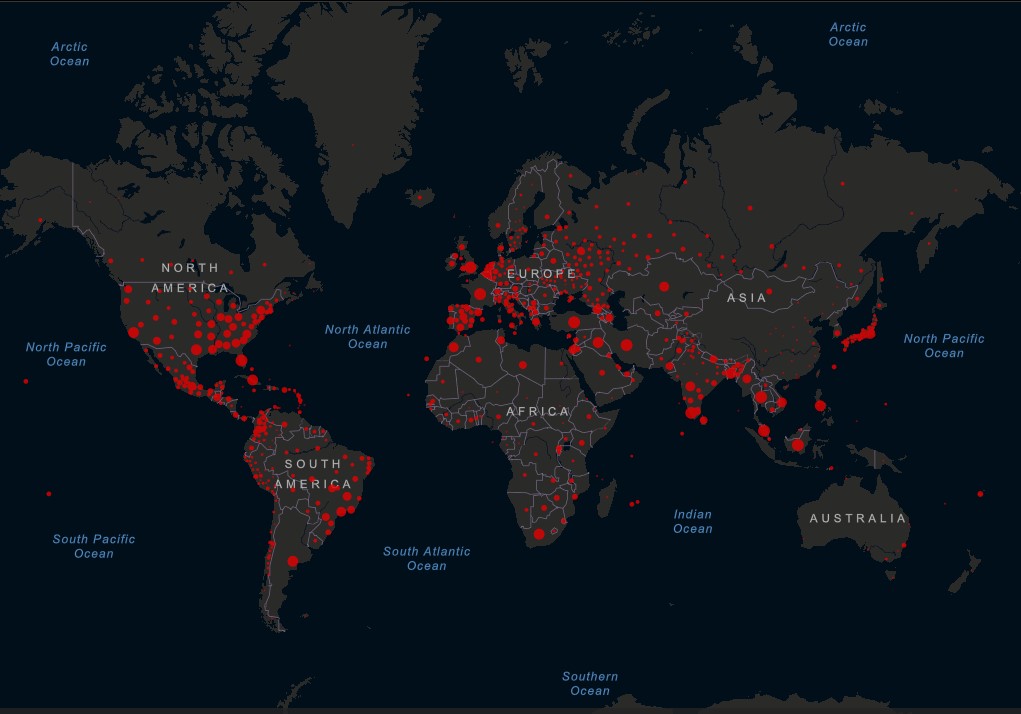
Introduction
SARS-CoV-2, officially designated as Covid-19 was initially detected in December of 2019. The onset of the virus was rapid with the virus spreading very quickly all over the world. Covid-19 has resulted in approximately 4.4 million deaths worldwide and more than 200 million total cases as of August 2021. The virus has caused significant damage to global economies as lockdowns forced businesses to shut down in the short term while also putting incredible pressure on hospitals and their employees. The virus originated in a Wuhan meat market where raw meat was being sold and it is considered likely that the virus-infected someone who came into contact with some raw meat. However, there is also increasing skepticism about this theory as many are suggesting that the virus was leaked from a medical laboratory that does gain-of-function research on coronaviruses.
Coronavirus Timeline
31 December 2019 – Wuhan Municipal Health Commission, China, reported a cluster of cases of pneumonia in Wuhan, Hubei Province. A novel coronavirus was eventually identified.
11 January 2020 – Chinese media reported the first death from the novel coronavirus.
13 January 2020 – Officials confirm a case of COVID-19 in Thailand, the first recorded case outside of China.
15 January 2020 – The Japanese Ministry of Health, Labour and Welfare informed WHO of a confirmed case of a novel coronavirus.
21 January 2020 – The United States of America (USA) reported its first confirmed case of the novel coronavirus.
24 January 2020 – France informed WHO of three cases of novel coronavirus, all of whom had travelled from Wuhan.
29 January 2020 – The United Arab Emirates reported the first cases in the WHO Eastern Mediterranean Region.
30 January 2020 – The Director-General of WHO declared the novel coronavirus outbreak a public health emergency of international concern (PHEIC).
2 February 2020 – First dispatch of RT-PCR lab diagnostic kits as sanctioned by the WHO.
11 February 2020 – WHO announced that the disease caused by the novel coronavirus would be named COVID-19.
25 February 2020 – Confirmation of the second case in the African Region, in Algeria. This followed the earlier reporting of a case in Egypt, the first on the African continent.
29 February 2020 – WHO publishes the guidelines for quarantining of individuals and clusters.
3 March 2020 – First recorded cases in India.
7 March 2020 – Total number of worldwide cases of Covid-19 pass 100,000
11 March 2020 – WHO classifies the novel coronavirus as a pandemic.
13 March 2020 – Europe had become the epicentre of the pandemic with more reported cases and deaths than the rest of the world combined, apart from the People’s Republic of China.
17 March 2020 – Brazil reports its first death due to Covid-19.
25 March 2020 – India imposes a nationwide lockdown
4 April 2020 – 1 million cases of COVID-19 had been confirmed worldwide and approximately 51,000 related deaths
10 April 2020 – Total deaths worldwide pass 100,000.
2 May 2020 – Pfizer-BioNTech started Phase 1/2 trial to test immune response and safety.
19 May 2020 – India overtook China in total Covid-19 cases as India hits the 100,000 milestone.
19 June 2020 – Cases in Brazil top 1 million and deaths approach 50,000.
28 June 2020 – Global deaths exceed 500,000 and confirmed cases top 10 million.
16 July 2020 – India crossed one million cases.
27 July 2020 – Moderna started Phase 3 trials.
5 August 2020 – Global death toll surpasses 700,000
11 August 2020 – Russia becomes the first country to approve a COVID-19 vaccine.
7 September 2020 – India overtakes Brazil as the second-worst hit country, with more than 4.2 million cases.
29 September 2020 – The world records a total of 1 million Covid-19 related deaths
2 October 2020 – India records 100,000 Covid-19 related deaths
2 December 2020 – The UK became the first country to formally approve Pfizer-BioNTech vaccine.
18 December 2020 – India records 10 million Covid-19 cases.
2 January 2021 – Alpha B1.1.7 (UK Variant) is identified in 33 other countries worldwide.
6 January 2021 – P.1 variant (Brazil variant) is identified.
16 January 2021 – India stars its vaccination drive.
7 April 2021 – India records 100,000 cases in one day and the following weeks sees the daily count increasing as deadly second wave grips India.
12 April 2021 – India surpasses Brazil for the second most total cases in the world with more than 11.3 million cases.
7 May 2021 – India reported a new record high for daily confirmed cases with 414,188 and 3,915 deaths and recorded a record 4,187 deaths the following day.
26 May – India surpasses 27 million total cases and 300,000 total deaths.
General Statistics

As of August 18, 2021, there have been more than 208 million cases recorded worldwide and 4.38 million deaths. The United States, India, and Brazil have recorded the most cases followed by Russia, France, the United Kingdom, and Turkey. Since the outbreak in January of 2020, the virus has left no country untouched with the cases being recorded in over 200 nations. The virus has been especially lethal in Peru where the death rate per 100,000 people stands at 617.1. This value is significantly higher than the second-place nation of Hungary where a death rate of 309.4 was recorded. The United States has recorded the most cases and deaths with 36.5 million cases and 618,784 deaths as of August 16, 2021. The deadliest day of the pandemic was recorded in India where on 8th May 2021 the country recorded 4,187 deaths and they also hold the record for most cases recorded in one day as two days prior on 6th May 2021, India recorded 412,262 cases in a 24-hour period. This was amidst the deadly second wave India experienced in April and May of 2021.
The vaccination drive is also in motion since the approval of vaccines in January of 2021. 197 countries are administering Covid-19 vaccines of which 67 are high-income nations, 103 are middle-income, and 26 are low-income. As of August 2021, 4.6 billion doses have been administered worldwide. Note that this value only accounting for the first doses. That is approximately 60.3 doses per 100 people. The nation with the highest number of doses administered thus far is China with 1.8 billion doses administered which relates to 128.6 doses per 100 people. This means across China; each citizen has at least got the first jab of a Covid-19 vaccine. India and the United States follow Chine with 543 million and 355 million doses administered respectively.
Biological Breakdown Of Coronavirus
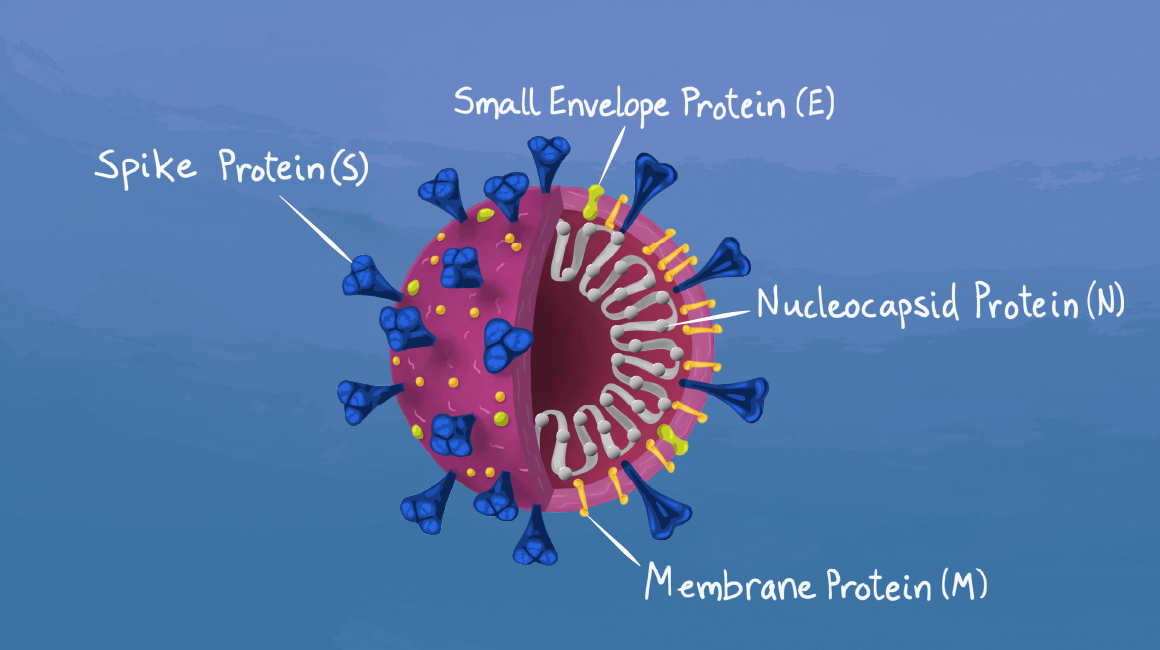
- SARS-CoV-2 belongs to a family of coronaviruses which are named as such due to the crownlike spikes on their surfaces. Covid-19 primarily attacks the throat and the lungs. The coronavirus must attack living cells to reproduce and spread throughout the body. The virus consists of four layers; viral genetic material (RNA), a protein shell, an outer envelope, and protein spikes that project from the envelope. The viral genetic material inside the protein shell contains the instructions to replicate the virus in foreign cells. The protein shell is a protective layer to protect the viral genetic material. The outer envelope allows the virus to infect cells by merging with the foreign cell’s outer membrane. The protein spikes are used as keys used to take control of the host cell and repurpose the machinery inside the cell to build the components of new viruses.
Transmission
Covid-19 is spread through close contact between individuals, close contact in this context is less than a meter distance. The virus itself is spread from person to person through aerosols or droplets which contain the virus and are inhaled or come into direct contact with the eyes, nose, or mouth. The aerosols or droplets are spread when coughing, sneezing, speaking, singing, or breathing. These particles range from larger respiratory droplets to smaller aerosols. The virus can also spread in poorly ventilated and/or crowded indoor settings, where people tend to spend longer periods of time. This is because aerosols remain suspended in the air or travel farther than 1 meter. People may also become infected by touching surfaces that have been contaminated by the virus when touching their eyes, nose, or mouth without cleaning their hands.
From a biological perspective, Covid-19 behaves like any other coronavirus. The virus will enter through a person’s nose or mouth and will come into contact with cells in the nose, throat, or lungs. Once inside, a spike on the virus will insert itself into a receptor molecule on your healthy cell membrane. This allows the virus to enter the healthy cell. A typical flu virus will travel to the nucleus of the cell where its genetic material is stored to infect the cell, SARS-CoV-2 however does not need to enter the nucleus as it is able to directly access the cell’s ribosomes. Ribosomes are macromolecular machines, found within all living cells, that perform biological protein synthesis. Ribosomes then use the viral genetic material to make viral proteins which are then carried by the Golgi apparatus in vesicles which then merge with the cell’s outer layer, the cell membrane. The combination of the viral proteins in the cell’s membrane causes a new virus to be formed which then spreads to other cells in the area.
Effect On Humans And Treatment/Containment

Covid-19 is known to produce pneumonia-like symptoms in those who are infected. This is primarily due to the virus’s effect on your lungs. Normally, when you breathe air is transferred from your trachea, also known as the windpipe, to large tubes called bronchi and then through smaller tubes called bronchioles which all lead the air into small sacs alveoli in your lungs. Alveoli are flexible and move in coordination with our breath. The alveoli are surrounded by small blood vessels called capillaries. Oxygen which you breathe in is passed from your alveoli to your bloodstream through the capillaries and carbon dioxide is passed in the other direction for you to expel from your body. Normally, the airways such as the trachea, bronchi, and bronchioles catch most of the germs that pass through them. Hair-like cilia push the germs and the mucus out of your airway and are normally expelled by coughing. In the situation that some germs make it past the cilia, the cells of your immune system attack the germs and viruses and make sure they can’t affect the alveoli.
In a body that is infected with the coronavirus, the immune system is weakened and is not able to battle the virus and germs and becomes overwhelmed. As a result, your bronchioles and alveoli become inflamed as your immune system continues to attack the multiplying viruses. The inflammation causes the alveoli to build up with fluid which makes it difficult for the body to get the oxygen that it needs. Those who are infected with the coronavirus are then in danger of developing Lobar pneumonia or Bronchopneumonia. The symptoms include difficulty breathing, chest pains, coughing, fevers and chills, confusion, headache, muscle pain, and fatigue. Coronavirus symptoms also include losing a sense of smell or taste. If left untreated, your body can go into respiratory failure wherein you are not able to breathe properly and get sufficient oxygen to your body.
Data has shown that the severity of the symptoms of Covid-19 depends primarily on age and the existence of other health conditions. Those who are suffering from underlying diseases are especially vulnerable as their immune system is already weak. People of older age are also more susceptible as their advanced age also makes their immune system weaker.
Coronavirus In North America
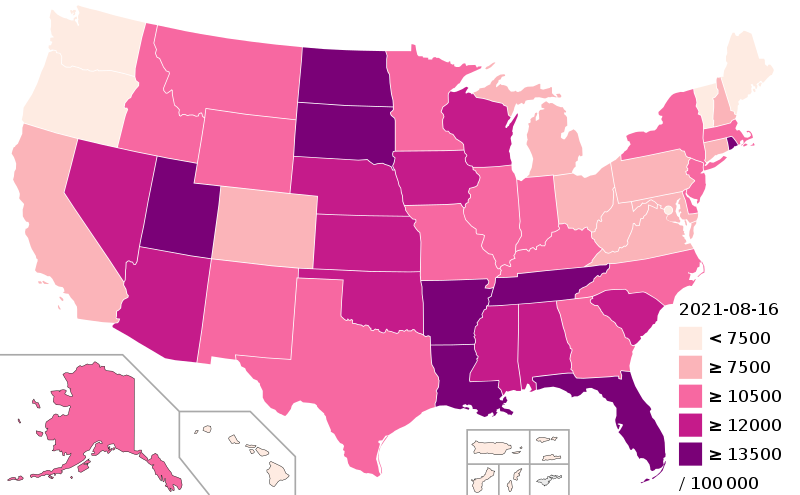
Covid-19 spread to North American fairly quickly after the initial outbreak in Wuhan, China towards the tail end of December 2019. The first case of Covid-19 was detected in the United States on 23 January 2020 in the state of Washington after a traveler from Wuhan had returned to the United States. Covid-19 had officially spread to all North American territories and countries after cases were confirmed on the Caribbean Island of Bonaire. The United States has been significantly hampered by Covid-19 as they became the nation with the most confirmed cases and deaths due to Covid-19 on 11 April 2020. They remain the world leaders in total cases detected and total deaths due to Covid-19. As of August 19th, 2021, there have been 37.1 million cases and 624,253 deaths. Los Angeles in the state of California has the cases and deaths with 1.3 million cases and 29,918 deaths. Behind the United States is Canada and Mexico. Canada has recorded 1.4 million total cases since the onset of the pandemic and 26,761 deaths as of August 2021. Mexico on the other hand recorded 3.1 million cases and recorded 250,469 cases as of August 2021. The remainder of North American countries and territories have recorded less than 1 million total cases and less than 6,000 deaths. This is not surprising as outside the major nations of the USA, Canada, and Mexico the population of North American nations is relatively small and as a result, we don’t observe a high number of cases. Interestingly the remote island of Greenland has also been infected with Covid-19, but they have only recorded 55 cases and reported no deaths.
Coronavirus In Latin America

Latin America has been one of the most affected regions of the world as a combination of densely populated areas, poverty and poor healthcare has meant that Covid-19 has been able to do a lot of harm to the region. Brazil has notably been heavily affected because of the pandemic and is the leader in South American in terms of cases and deaths due to Covid-19. The first case of Covid-19 was recorded in São Paulo, Brazil on 26th February 2020. By 3 April, all countries and territories in South America had recorded at least one case. In the early months of the pandemic, Europe was the epicenter of the virus as they recorded the most cases and deaths however by May of 2022, the cases in Latin America were so widespread and abundant that WHO declared Latin American the new epicenter of the pandemic. As of 16 July 2021, Latin America had recorded 34,359,631 confirmed cases and 1,047,229 deaths from Covid-19. Due to a shortage of testing and medical facilities, it is believed that the outbreak is far larger than the official numbers show.
Brazil is the third highest in the world in cases recorded and deaths with 20.4 million cases and 571,662 deaths. Brazil’s government has been widely criticized for the severity of the pandemic as they opted not to follow WHO guidelines to limit transmissions and instead chose to discredit the danger posed by the virus. Argentina, Chile, Colombia, and Peru all have more than a million total cases. Peru notably has suffered recently due to the countries poor infrastructure and economic situation which only resulted in multiplying the effect of the pandemic.
Coronavirus in Europe

Europe was the epicenter of the pandemic in the early few months after WHO officially declared it a pandemic. Italy was notably struggling as the virus was widespread and shortages of hospital beds, ventilators, and oxygen resulted in a crisis where hospitals had to choose which patients to save. Italy was one of the first countries in Europe to diagnose a case of Covid-19, with its first official case being detected on February 21st, 2020. By 13th March 2020, Europe had overtaken China for a total number of cases. By 17 March 2020, all countries within Europe had a confirmed case of Covid-19, with Montenegro being the last European country to report at least one case. At least one death has been reported in all European countries, apart from the Vatican City. Europe, along with the rest of the world, was swift in issuing national lockdown once the severity of the pandemic became clear and by 18th March 2020, more than 250 million people were in lockdown in Europe alone.
The European countries with the highest number of confirmed Covid-19 cases are Russia, the United Kingdom, France, Turkey, and Italy. As of 16th July 2021 France, Turkey, Russia, United Kingdom have recorded a total of at least 5 million cases. Covid-19 has been most lethal in Russia with 146,069 deaths followed by UK, Italy, and France who have all recorded more than 100,000 deaths.
Coronavirus In Asia
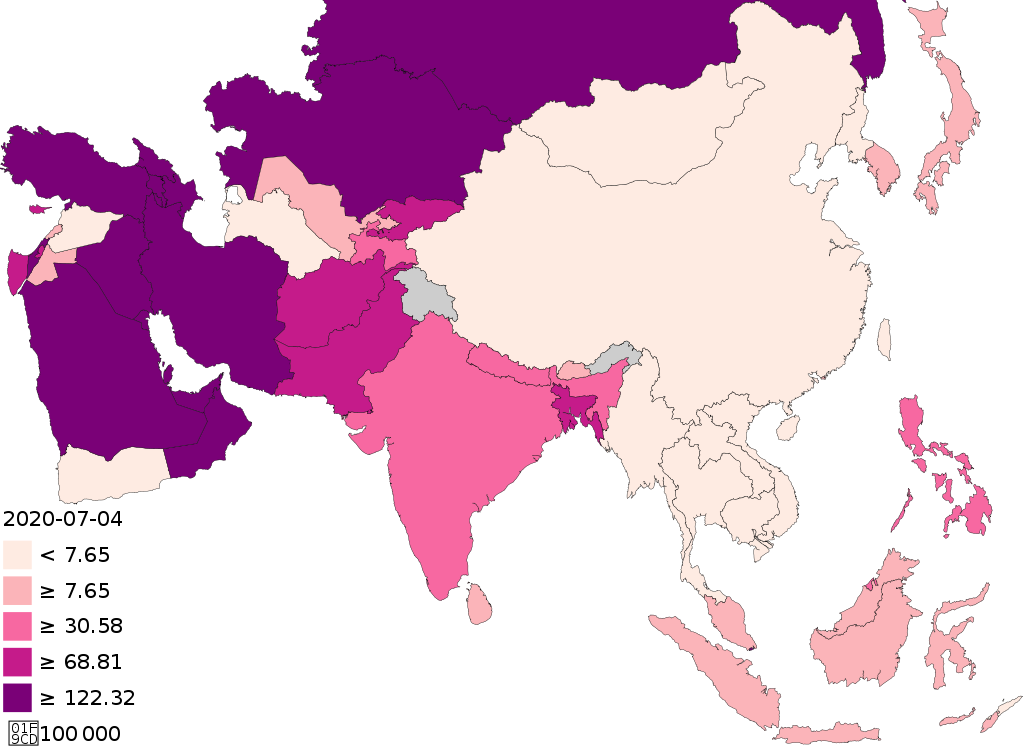
Asia is where the Covid-19 virus first originated. Wuhan in the Hubei province of China was the epicenter of the virus until the virus spread to Europe. As of 19th August 2021, at least one case of Covid-19 had been reported in every country in Asia except North Korea and Turkmenistan. Information from North Korea however is highly unreliable and the extent to which Covid-19 spread to the country remains unknown. Despite being the first area of the world hit by the outbreak, the early wide-scale response of some Asian states, particularly Bhutan, Singapore, Taiwan, and Vietnam have allowed them to fare comparatively well. China was criticized for initially minimizing the severity of the outbreak, but its wide-scale response has largely contained the disease since March 2020.
India, Indonesia, Iran, Iraq, Philippines, Bangladesh, Malaysia, and Pakistan are all Asian nations that have recorded a total of more than 1 million cases of Covid-19. Turkey and Russia can also be included in this list but as I included them in the European subsection of this article, I will not be including them here. India has recorded the most deaths due to Covid-19 in Asia with a total of 434,784 deaths as of August 2021. Outside of India, the countries where Covid-19 has been most lethal are Iran and Indonesia where 83,739 and 88,800 deaths were recorded respectively. One country of note in Asia regarding Covid-19 is North Korea as North Korea is especially vulnerable due to its health care system being underfunded, lacking crucial medical supplies even under normal circumstances.
Coronavirus In India

As of the 23rd of August 2021, India has recorded a total of 32,424,234 cases and 434,367 deaths which ranks India as the second in terms of cases and third in terms of deaths. There are also questions being raised about the reporting of the cases in India and there are reports of severe under-reporting. Covid-19 spread to India around January of 2020 with the first confirmed case of the virus was confirmed on the 30th of January when three Indian students returned from Wuhan to three separate towns in Kerala. Lockdowns came into effect in Kerala on 23rd March and the rest of the nation followed on 25th March of the same year. By mid-May 2020, five cities accounted for around half of all reported cases in the country: Mumbai, Delhi, Ahmedabad, Chennai, and Thane and on 10 June, India’s recoveries exceeded active cases for the first time. By September 2020, infection rates decreased along with the number of new and active cases. Daily cases peaked mid-September with over 90,000 cases reported per day, dropping to below 15,000 in January 2021.
India’s handling of the virus was widely praised as a swift action in the form of lockdowns and effective containment and treatment meant that by the arrival of the new year cases in India were decreasing and the infection rates were being curbed. However, the second wave that began in March 2021 devastated the nation as a combination of election rallies, religious gatherings,s, and poor government advice led to the virus spreading rapidly all over the nation and overwhelming hospitals. Shortages of vaccines, hospital beds, oxygen cylinders, and other medicines in parts of the country led to global media coverage and widespread criticism of the government and their handling of the pandemic. By late April, India led the world in new and active cases. On 30 April 2021, it became the first country to report over 400,000 new cases in a 24-hour period. India also recorded the most deaths in 24 hours when on 8th May 2021 there were more than 4,000 deaths recorded. Since June 2021, the daily rate of cases has decreased, and the infection rates have been curbed and as of August 2021, there are, on average, 33,000 new cases per day. India is also the origin of the more ‘spreadable’ Delta variant, which most likely mutated during the deadly second wave.
Part of the decrease in cases and deaths has been due to the vaccination drive undertaken by the government. India’s vaccination drive started on January 16th, 2021. with AstraZeneca vaccine (Covishield) and the indigenous Covaxin. Later, Sputnik V and the Moderna vaccine were approved for emergency use too. As of 17 August 2021, the country had administered over 550 million vaccine doses.
Coronavirus In Africa
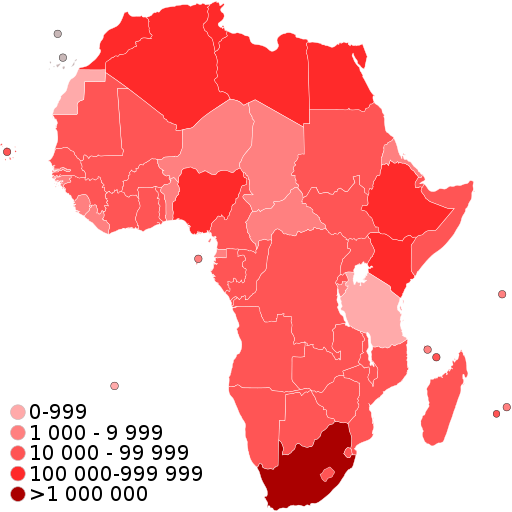
Covid-19 was first confirmed in Africa when a case was recorded in Egypt on 14 February 2020. The first confirmed case in sub-Saharan Africa was announced in Nigeria at the end of February 2020. Within three months, the virus had spread throughout the continent, like Lesotho, the last African sovereign state to have remained free of the virus, reported a case on 13 May 2020. By 26 May, it appeared that most African countries were experiencing community transmission, although testing capacity was limited. June 2021 saw the third wave of infections hit the African continent as 14 nations saw an increase in cases. By the beginning of July, there were more than 251,000 new Covid cases, a 20% increase from the prior week and a 12% increase from the January peak. There are also widespread cases of under-reporting as well due to underdeveloped healthcare systems in some countries. Notable variants from Africa include the Beta variant from South Africa and the Eta variant from Nigeria.
The African Union secured close to 300 million Covid-19 vaccines on 13 January 2021. Notably, however, African countries were being charged more than double what European countries had to pay for certain vaccines. Africa is the world’s least vaccinated continent. At the beginning of June 2021, the World Health Organization reported that Covid-19 vaccine shipments had ground to a “near halt” in Africa. By 8 July 2021, only 2% of the continent had been inoculated.
Coronavirus In Australia and New Zealand
- The COVID-19 pandemic was confirmed to have reached Oceania on 25 January 2020 with the first confirmed case reported in Melbourne, Australia. It has since spread elsewhere in the region, although many small Pacific Island nations have thus far avoided the outbreak by closing their international borders. Three Oceania sovereign states (Nauru, Tonga, and Tuvalu) and one dependency (Cook Islands) have yet to report a case. Australia and New Zealand have received praise for their handling of the pandemic in comparison to other Western nations, with both New Zealand and each state in Australia wiping out all community transmission of the virus several times over even after it being re-introduced into the community. Australia recorded 32,917 cases and 918 deaths and New Zealand recorded 3,054 cases with 26 resultant deaths as of August 2021.
Vaccination

To understand how a Covid-19 vaccine operates, it is important to understand how our body reacts to the invasion of germs such as viruses and bacteria. When germs, such as the virus that causes Covid-19, invade our bodies, they attack and multiply. This invasion, called an infection, is what causes illness. White blood cells are the primary tools used to fight infections and different types of white blood cells fight infections differently. There are three types of white blood cells that fight infections: macrophages, B-lymphocytes, and T-lymphocytes. Macrophages are white blood cells that swallow up and digest germs and dead or dying cells. The macrophages leave behind parts of the invading germs, called “antigens”. The body identifies antigens as dangerous and stimulates antibodies to attack them. B-lymphocytes are defensive white blood cells. They produce antibodies that attack the pieces of the virus left behind by the macrophages. T-lymphocytes are another type of defensive white blood cell. They attack cells in the body that have already been infected. Normally, when infected with Covid-19, it takes the body days or weeks to find the right antibodies required to fight the virus and after the infection has been overcome, the body remembers what it learned about how to fight that specific disease. The body keeps a few T-lymphocytes, called “memory cells,” that go into action quickly if the body encounters the same virus again.
Different types of vaccines work in different ways to offer protection. But with all types of vaccines, the body is left with T-lymphocytes as well as B-lymphocytes so that in case the virus is encountered again, the body will be able to effectively fight the virus. It typically takes a few weeks after vaccination for the body to produce T-lymphocytes and B-lymphocytes. There are three types of vaccines that are widely recognized and authorized on a global scale.
The three types are mRNA vaccines, protein subunit vaccines, and vector vaccines. mRNA vaccines contain material from the virus that causes Covid-19 that gives our cells instructions for how to make a harmless protein that is unique to the virus. After our cells make copies of the protein, they destroy the genetic material from the vaccine. Protein subunit vaccines include harmless pieces (proteins) of the virus that causes Covid-19 instead of the entire germ. Vector vaccines contain a modified version of a different virus than the one that causes Covid-19. Inside the shell of the modified virus, there is material from the virus that causes Covid-19. This is called a “viral vector.” Once the viral vector is inside our cells, the genetic material gives cells instructions to make a protein that is unique to the virus that causes Covid-19. In all the above cases our bodies recognize that the protein should not be there and build T-lymphocytes and B-lymphocytes that will remember how to fight the virus that causes Covid-19 if we are infected in the future. Vaccines normally require 2-doses to be administered in the space of 2-4 weeks although some vaccines only require one.
Summary
- Covid-19 has affected our planet for more than 18 months now and has changed key aspects of our way of life. Working from home and hybrid working has become more common as business that was forced into remote working because of lockdowns are realizing the value that comes with remote working. Global economies are slowly recovering as most nations are administering vaccines in large quantities and lifting lockdowns. Globally USA, India, and Brazil are still leading the world in Covid-19 cases and deaths as of August 22nd, 2021. Globally, 4.9 billion doses of a vaccine have been administered and all signs indicate that by the new year rolls around we can expect most countries to have recovered from Covid-19 and be largely protected from the virus.
Top 13 Interesting Facts
The term “coronavirus” refers to a family of viruses that causes many different types of diseases, including the common cold. Covid-19 is a “novel coronavirus,” which means it’s a new disease unfamiliar to scientists and doctors.
CO-VI-D-19: CO stands for “corona,” which means “crown” in Latin, and the viruses are named for the crown-like spikes on their surface; VI stands for “virus”; and D is for “disease.” The “19” comes from the year 2019 when the disease was first detected.
The human body actually has billions of T-lymphocyte cells that each have antidotes for every possible disease in the universe. The difficult part is finding the appropriate response to a virus before it does irreparable damage to the body.
Many people who become infected (one in five people) do not even have a cough. The disease proceeds without any symptoms at all: a person may not even suspect that he is sick.
One of the most unusual symptoms of coronavirus is the loss of a sense of taste and/or smell.
The more deadly a virus is, the worse it is spreading. By killing its master, the virus can no longer infect others. Therefore, the virus rarely mutates into a more deadly form, it is not in its interests.
On average, each carrier of a new coronavirus manages to infect 2 to 4 healthy people. This number is higher than seasonal flu (1.3), but lower than measles (12+).
In South Korea, the virus was controlled until the number of cases reached 30. But the woman, codenamed “Patient 31”, immediately infected about 1,200 people after attending two religious festivals.
The mortality rate from Covid-19 is still difficult to calculate with accuracy, but most studies estimate it at 1-3%.
The pandemic developed quickly: 100,000 patients 67 days after the first diagnosis, the second 100,000 became ill in 11 days, and the third – in 4 days.
Pets cannot spread the coronavirus. No cases of human infection from a dog or cat have yet been reported.
In the air, the coronavirus remains viable (that is, it can infect healthy people) for three hours.
The smallest drop of saliva from an infected person may contain billions of virus particles.






